THEN AND NOW - Volume 1
Articles from Discover the Treasures
- CHESTNUT AND PINE - 1930 - 2009
- WEST SIDE OF PINE STREET BETWEEN WASHINGTON AND CHESTNUT STREETS - 1898 - 2009
- NORTHWEST SIDE OF MILWAUKEE BETWEEN CHESTNUT AND PINE STREETS - 1908 - 2010
- CITY AND TOWN HALL AND TREND SETTERS - 1905 -2010
- STATE STREET BETWEEN PINE AND PERKINS BOULEVARD - 1898 - 2009
- SOUTHEAST CORNER OF MAIN AND JEFFERSON STREETS - 1882 & 1956 - 2010
- WEST SIDE OF MILWAUKEE AVENUE BETWEEN ECHO LAKE AND GROVE STREET - 1896, 1957, AND 2010
- KANE STREET HOUSES BETWEEN DUANE STREET AND HIGHLAND AVENUE - EARLY 1900s - 2010
- CORNER OF LEWIS STREET AND MILWAUKEE AVENUE - 1907 - 2010
- SOUTH CORNER OF CHESTNUT STREET AND MILWAUKEE AVENUE - EARLY 1920s - 2010
CHESTNUT AND PINE - 1930 - 2009


The Bank of Burlington building, also known as the McCanna building, is shown at the northeast corner of Pine and Chestnut Streets in the circa 1930 photo (left) taken by Charles Warner of Warner Studios. The photo was recently donated to the Burlington Historical Society by Patrick McCanna, of Brown’s Lake, great grandson of Charles B. McCanna, who built the McCanna building. The McCanna building is now occupied by May’s Insurance Company, as shown in the 2009 photo (right).
In the circa 1930 photo, Reineman’s Hardware is in the Bankes building next to the McCanna building on Pine Street. That building is now occupied by Bulletin Printing and Office Supplies, Inc. The corner of the former Hotel Burlington building, now occupied by the Sci-Fi Café, is partially visible next to the Bankes building.
The Finke building with the turret in the circa 1930 photo was occupied at that time by a tavern run by George Thomas. The Finke building burned out in June 1978 at the time it was occupied by Natale’s Pizza Restaurant and was replaced by the one-story building shown in the 2009 photo, which is now occupied by Zumpano’s Ristorante & Pizzeria.
The truck with the chicken-shaped top parked by the Finke building was the delivery truck of the Sperry Candy Co. of Milwaukee, which made the Chicken Dinner and Denver Sandwich candy bars. The Sperry Candy Co. was owned by Ray Pihringer of Burlington and Miles Sperry of Elkhorn.
The overhead wires and poles, which are visible in the circa 1930 photo, were moved from the main business streets to the alleys in 1931 and 1932. Note the traffic signal hanging in the middle of the intersection in the circa 1930 photo.
WEST SIDE OF PINE STREET BETWEEN WASHINGTON AND CHESTNUT STREETS - 1898 - 2009
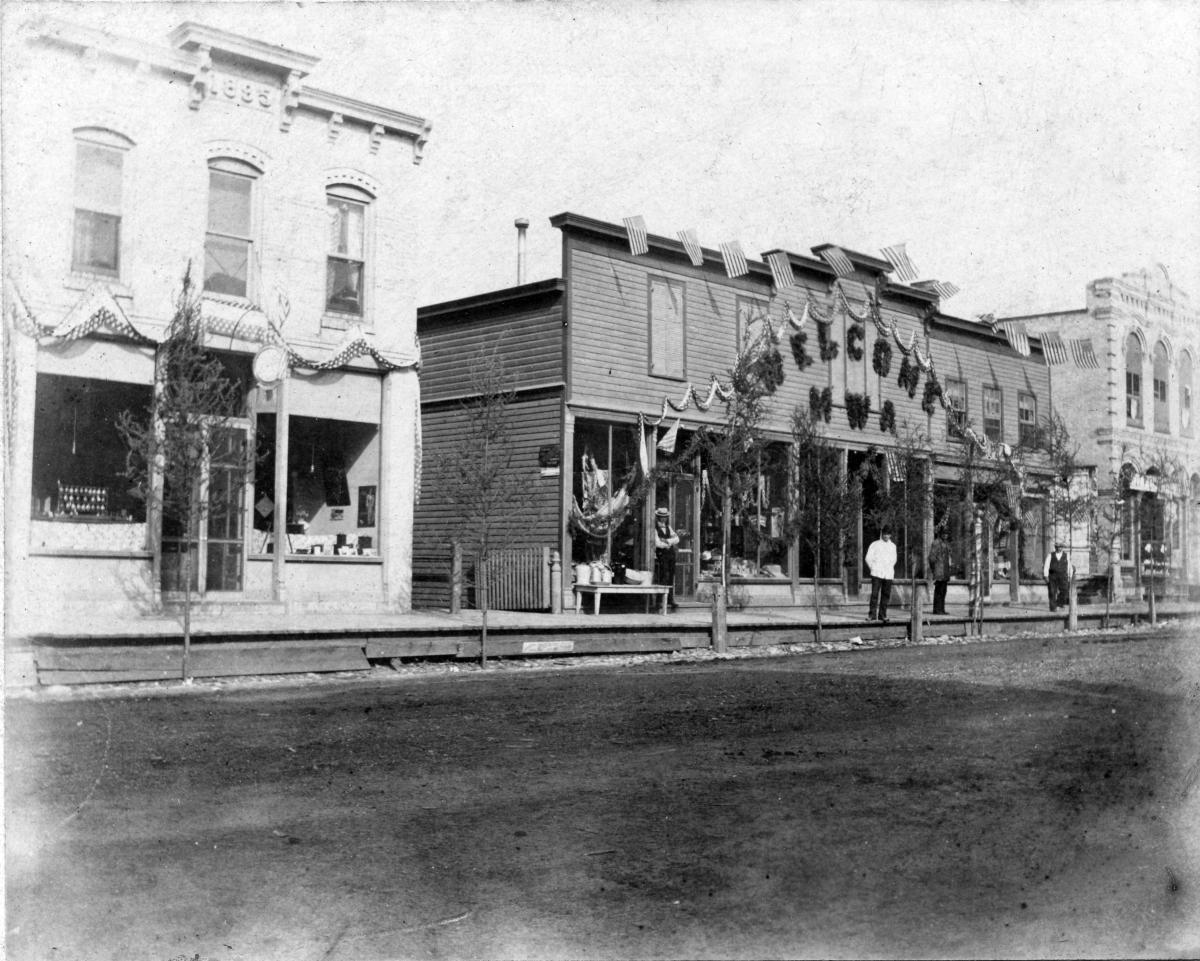

Wooden sidewalks, dirt streets, stone gutters, and hitching posts were the norm in downtown Burlington when the photo (left) of the store buildings on the west side of Pine Street between Washington and Chestnut Streets was taken in 1898. The photo was recently donated to the Burlington Historical Society by the children of the late Martin and Evelyn Itzin.
The store building on the left, which replaced a stone residence, was built in 1895 by Charles F. Keuper. The mason work was done by Gustave Zerneke and the carpenter work by Frank Vande Sand and Joseph Salisbury. The first occupant was Ernest Starkey, who moved his jewelry store from the Schwaller building on the east side of Pine Street to Keuper’s new building. Starkey, with his family, also occupied the upstairs rooms. Clarence Gleason bought Starkey’s jewelry business in 1897 and remained in the Keuper building until 1904 when he and Leroy E. Crawford, who had bought an interest in Gleason’s business in 1900, moved to the Neuhaus building on Chestnut Street. (That building is now part of the Chase Bank building.)
After Gleason and Crawford moved out, a shooting gallery and a furniture repair and upholstery shop occupied the Keuper building for short periods until Bernard Willich rented the store in late 1905 and opened a grocery and notions business. Adolph Richter bought the business from Willich in 1910 and, about a year later, sold it to Frank Mathews. In 1914 John Jensen moved his bakery into the building, which continued to house bakeries under succeeding owners Fred Coulthard, P. R. Wallingford, John Bauman, and Frank Granzow until 1920. In 1921 Louise Voelker and Charlotte Miller moved their millinery shop into the building. In 1940 Miss Miller sold an interest in the millinery shop to her niece, Carla Kunkel, who operated it as Carla’s Hat Shop until 1942, when she sold it to Mrs. Blanche Goodwin and Mrs. Rose Mathews, who changed the name to B & R Hat Shop.
In 1946 Mrs. Mathews sold the business to Wilford and Lenora Graves, who started a sportswear and children’s business named The Smart Shop. Subsequent businesses in the building included Julie’s Closet, Headley’s Home Medical Supplies, and Rustic Hut. The building is currently occupied by a portion of the Schuette & Daniels furniture business, as shown in the right photo.
The main Schuette & Daniels building is also seen in the right photo, which was taken in March 2010. The large brick building was erected by the Keuper Estate in 1914, replacing the wooden building shown in the 1898 photo. (The "Welcome MWA" sign refers to the Modern Woodmen of America, while the flags and bunting decorate the buildings for Burlington’s Fourth of July celebration which the MWA sponsored in 1898.) The wooden building, which consisted of four stores, had been created in 1896 when Charles Keuper moved the center part, which had housed his blacksmith shop, closer to the street, remodeled it into two stores, and aligned it with the store buildings on either side, which Keuper also owned. Occupants of the Keuper stores in 1914, just before the wooden building was razed, were Mrs. Louisa Keuper’s toy and notion store, Arthur H. Mueller’s plumbing shop, Leonard J. Smith’s Fairbanks-Morse farm implement store, John Jensen’s bakery, and Joseph P. Schiefen’s real estate office.
The first occupant of the large brick building in 1914 was William Rosenberg’s dry goods store, with other businesses and professionals occupying rooms and offices on the upper floor. In 1939 Montgomery Ward leased the building and opened a department store, which operated until 1973. Rogan’s Shoes occupied the building for about four years. Schuette & Daniels moved its furniture business into the building in late 1978.
The building at the far right in the 1898 photo was demolished in 1971 to make way for the bank drive-in seen in the 2010 photo. That building was erected by Henry Stang in 1872 and had housed such businesses as the Stang family’s City of Paris variety store, Mathilda and Minna Wald’s Specialty Shop, and Vogue Beauty Shop.
NORTHWEST SIDE OF MILWAUKEE BETWEEN CHESTNUT AND PINE STREETS - 1908 - 2010

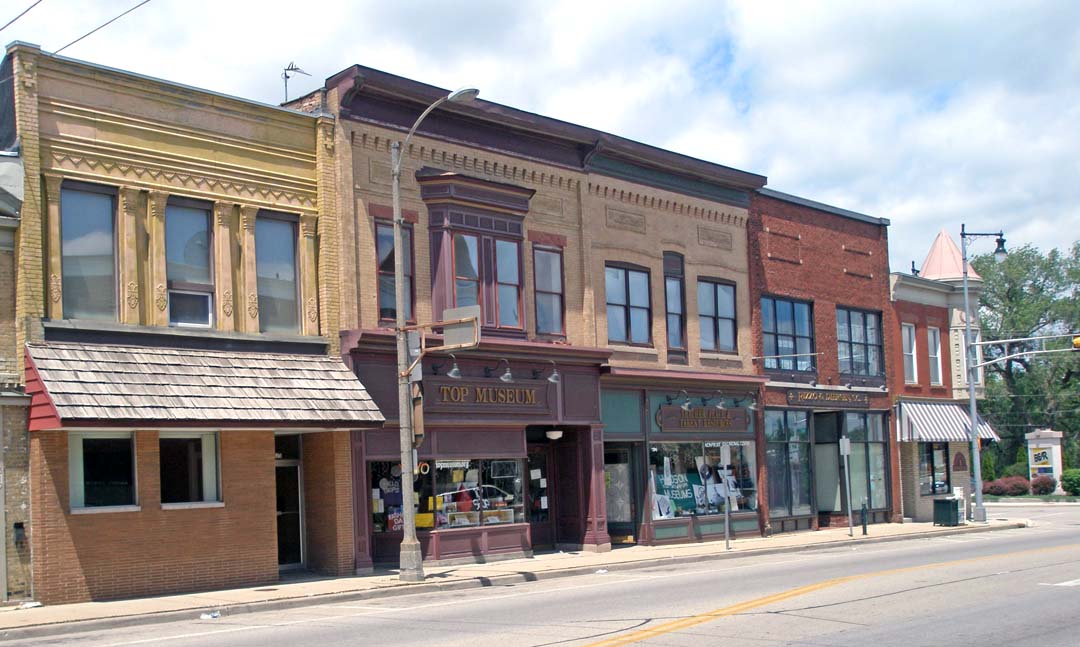
Five buildings on the northwest side of Milwaukee Avenue between Chestnut and Pine Streets are shown in the circa 1908 photo and in a photo taken in 2010. Except for the conical tower on the building on the far right, the buildings no longer wear the "crowns" and other rooftop ornamentation they did in the earlier photo. The large fabric awnings, so prominent on the three middle buildings in the earlier photo, have also disappeared. And the front of the first floor of the building on the left shows a much different look today than it did in the early 1900s.
The second stories of the buildings, however, except for that of the fourth building, which has been considerably altered and no longer has a bay window, still look much the same as they did more than a century ago. Playing an important role in the similarities that can be seen in the two photos were the restoration efforts that the building owners have carried out with the cooperation of the City’s facade grant program.
The occupants of the five buildings have also changed over the years, in most cases multiple times. Cigar-maker Ben Holmes’ tobacco "factory" occupied the building at the left at the time the upper photo was taken. Today, the building is occupied by Manor Sales & Marketing, Inc., a food and beverage industry firm. Other occupants over the years have included the restaurants of Fred Powers, Conrad Waldvogel, and Fred Boulden; Pantorium cleaners; Jane’s Beauty Shop; Gamble Store; Co-op grocery store; Motor Parts Co.; and Kelly & Richter law office. The building was erected in 1894 by George Schumann on a lot previously owned by Carl Wagner between Schumann’s tavern building, the corner of which can be seen in the circa 1908 photo, and Wagner’s blacksmith shop.
The second building from the left is occupied today by the Spinning Top Museum. It was erected in 1907 by Henry Zimmermann for his newspaper publishing and printing businesses. The building replaced the former building, a single-story blacksmith shop that Zimmermann had purchased in 1896 for his businesses. Those businesses occupied the building until 1984 when they were moved to the former Wisconsin Electric building (now occupied by Standard Press / Southern Lakes Publishing) on North Pine Street.
The middle building, now occupied by Teacher Place, was occupied by Peter J. Strassen’s grocery store at the time of the circa 1908 photo. Strassen had leased the building from George McDonald, who had erected it in 1907 to replace an earlier building, erected in 1896, which had been occupied by a laundry. Strassen operated the grocery store until 1929, when he sold the business to Mrs. Vincent Uhen. Later occupants included the Badger Paint Store, which occupied the building from 1931 until the early 1970s, and the Dyke and Burlington Sewing Centers.
The fourth building, now occupied by the Rizzo and Diersen law office, was also built by George McDonald in 1896 on a vacant lot he had purchased from William J. Pieters, who operated a wagon and woodworking shop on the corner. McDonald leased the building to Elmer L. Newbury, who moved his Mascot saloon and restaurant there. The building continued to house saloons until 1919, when Prohibition went into effect. Those operating saloons in the building included Philip Wieselmann, Charles Beller, John B. Richter, John Schmidt, Frank Huebner, John Beix (who occupied the building at the time of the circa 1908 photo), Bernard Kortendick, Henry B. Heiderman, William H. Rittman, John Ketterhagen, John Brickner, Albert Timm, Ben Schultz, Gottlob Stradinger, and Frank Bengston. Later occupants included the Burlington Cash Market of Louis Voelz and Roy H. Kolstedt, Kruckman and Glaser's Hardware store, Glaser Hardware Co., and JLS Vacuum Inc.
The corner building with the tower, occupied by The Daily Brew at the time of the 2010 photo, was erected by Henry F. Woeste in 1906. It replaced William J. Pieters’ wagon and woodworking shop. Woeste and others, including William Heiderman, Julian and Urban Weiler, Alwyn and Agnes Long, Henry M. and Kay Lloyd, Joseph and Kay Pisula, Ken Ketterhagen, Joe Kuhn, Dick McCabe, Sandy Ketterhagen, and Robert and Nora Smith, operated saloons and taverns in the building until the mid-1990s. King’s Travel and Cruise Centre and Burlington Travel Inc. occupied the building before Nordahl and Sue Unbehaun opened The Daily Brew in 1999. In 2001 the business was sold to Pat and Kris Clark.
The Bert Mathews Livery building, seen at the far right in the circa 1908 photo, occupied the corner where the Bear Realty parking lot is now located.
CITY AND TOWN HALL AND TREND SETTERS - 1905 -2010

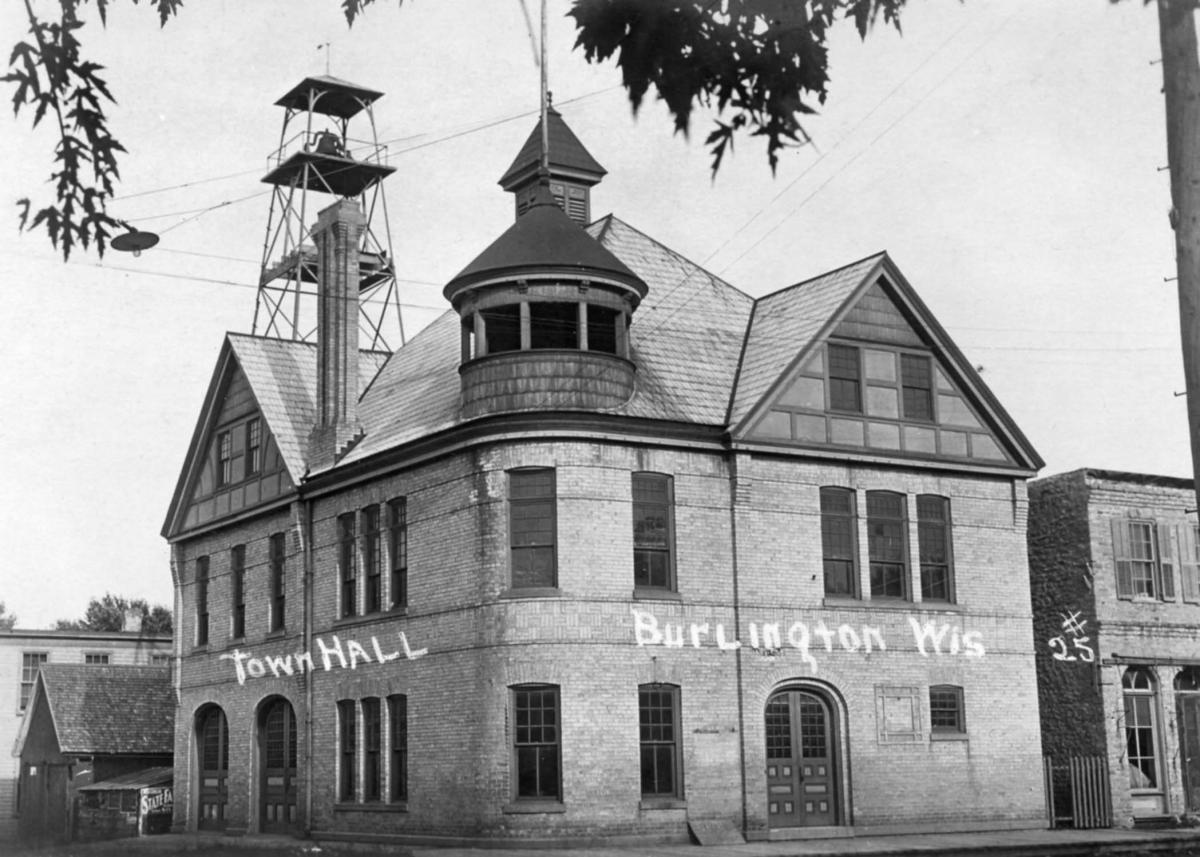

Sitting on a corner of a block that was originally intended as a city park, the building currently occupied by Trend Setters on the southeast corner of Pine and Washington Streets (see 2010 photo at right) has gone through considerable change over the years.
When Silas Peck filed his original plat of Burlington with the county clerk’s office in 1839, he designated the block bounded by Pine, Washington, Dodge, and Jefferson streets as a public square. The square remained undeveloped and, at Peck’s death in 1864, became part of his estate. Peck’s son, William, then began selling off lots in the block. In 1865, Herman Thiele, who had a hardware business in the next block north on Pine Street, bought the corner lot, built a frame building, and started a tin shop.
The frame building later housed a cigar maker and tobacco store, a general fur store, and a tailor. In 1888 the town and village of Burlington bought the corner from then-owner Charles B. Wagner and put up the large brick building with the peaked roofs and the corner tower shown in the 1905 photo at left above. The building, which included an engine room for fire equipment, was used as the town and village (and later city) hall. The public library also moved into the building’s second floor in 1913.
The building served as the fire station until 1921, when the fire department moved north on Pine Street to a building near Mill Street, and as the town hall until 1924, when the city bought the town’s interest and the town offices moved a block west to the corner of Washington and what is now N. Perkins Boulevard. In 1925 the city traded the building and property (plus $3,000) to Albert J. Tichlofen for the property on the corner of Pine and Jefferson Streets where the city intended to build a new City Hall. The city offices and library remained in the building until 1926, when they were moved to the newly built (and current - 2011) City Hall building.
After the 1925 trade, Tichlofen sold the property to be vacated by the city to the Masonic lodge, which bought it as a possible site for its temple. When those plans changed, the Masonic lodge sold the former city and town hall building and property in 1926 to Joseph Bazal, who had a creamery in the building on Washington Street that currently houses a laundromat. Bazal removed the peaked roofs and corner tower, razed the fire tower, built additions on both wings of the building, and remodeled the building into a creamery and retail dairy store (shown above right). He offered to donate the fire bell and tower to Rochester, but it did not accept them because of the expense that would have been involved in moving them.
Bazal sold an interest in the creamery to Eugene and Elmer Weber in 1949, when the photo showing the creamery was taken. Bazal retired in 1950, and the Weber brothers moved the business to the corner of Pine and State Streets in 1951. Since then, the building has housed a variety of businesses and offices, including William Popp’s dental laboratory, Dr. John Consoer’s laundromat, Jean MacReady’s "the think shop" bookstore, Wegge’s Liquor and Cheese Mart, Sliker’s Liquor Store, Alcove Bookshop, the Candy Kitchen, Teacher Place, Heritage Draperies, and others. Trend Setters beauty salon has occupied the building since 1987.
STATE STREET BETWEEN PINE AND PERKINS BOULEVARD - 1898 - 2009


St. John the Divine Episcopal church stands by itself at the far right in the circa 1898 panoramic photo taken looking southeast from the Lincoln School corner of State Street and what is now Perkins Boulevard. Only a few houses and other buildings existed at that time on the east side of Perkins Boulevard. The photo was taken with an Al-Vista panoramic camera that was made in Burlington by the Multiscope and Film Co.
The area where the church is located had, until 1893, been part of the Frederick Stanton Perkins farm which, with some exceptions, stretched from State Street on the north to Market Street on the south and from Pine street on the east to Kane street on the west. The church was completed and dedicated in 1894.
The right panel of the three-panel composite photo taken in December 2009 shows the Episcopal church barely visible through the trees. The former Methodist church building, now the CATHE Center, is at the right. The Methodist church was built on that corner in 1905. A full complement of houses now lines the east side of Perkins Boulevard.
The two-story frame house (center of both images) with the square, or hip, roof , the side bay window, and one-story rear addition was built by Bernard Brehm in 1883 as a rental property. The large front porch with the upper railing, shown in the 2009 composite photo, was added later. Among those who rented that house were William and Mary (nee Wambold) Bennett, Fred and Agnes (nee Coulthard) Ebbers, Dr. H. J. Winters, Mrs. Elizabeth Kennedy, John Madden and family, Dr. Ernest B. and Nellie Guild, Mrs. Ellen Hartnell, and Michael May and family.
The house was sold by the Brehm descendants in 1917 to Theodore Linneman, who rented it to the Seymour White family. Linneman sold the house in 1920 to Fred Kitterer, who occupied it for many years.
Bernard Brehm and members of his family lived in the house with the columned porch (partially visible at the left in the circa 1898 photo) from the 1870s until the early 1970s. After son Frank Brehm’s death in 1973, William Humphrey bought the property and, in 1974, the house was moved to the corner of Robert and Henry Streets, where it faces Karcher Middle School, formerly Burlington High School. Humphrey built a new residence and office on the property.
The house on State Street east of the "square" house was the home of the William F. Brehm and son-in-law Victor Markofski families for many years. Brehm bought the property from Mrs. Robert L. Ransom after her husband’s death in 1901.
Partially hidden by the tall pine tree, the next house east on State Street in the December 2009 composite was moved to that location in 1900 by Herman and Hattie Dettman, who bought the lot (shown empty in the circa 1898 photo) from Robert L. Ransom. The house sits next to the brick house, seen in both photos, on the corner of State and Pine Streets. That house, 101 S. Pine Street, is now the site of Massages by Nikki. To the left of the brick house and farther east on State Street near Dodge Street, is the Newell barn, the first home of the Haylofters little theater group. That property is now the site of the Burlington Post Office, part of which is seen in the December 2009 composite. In the distance in the composite on the south side of State Street is the Maple Leaf Farms / Burlington Feed Mill plant at 100 S. Dodge Street.
SOUTHEAST CORNER OF MAIN AND JEFFERSON STREETS - 1882 & 1956 - 2010

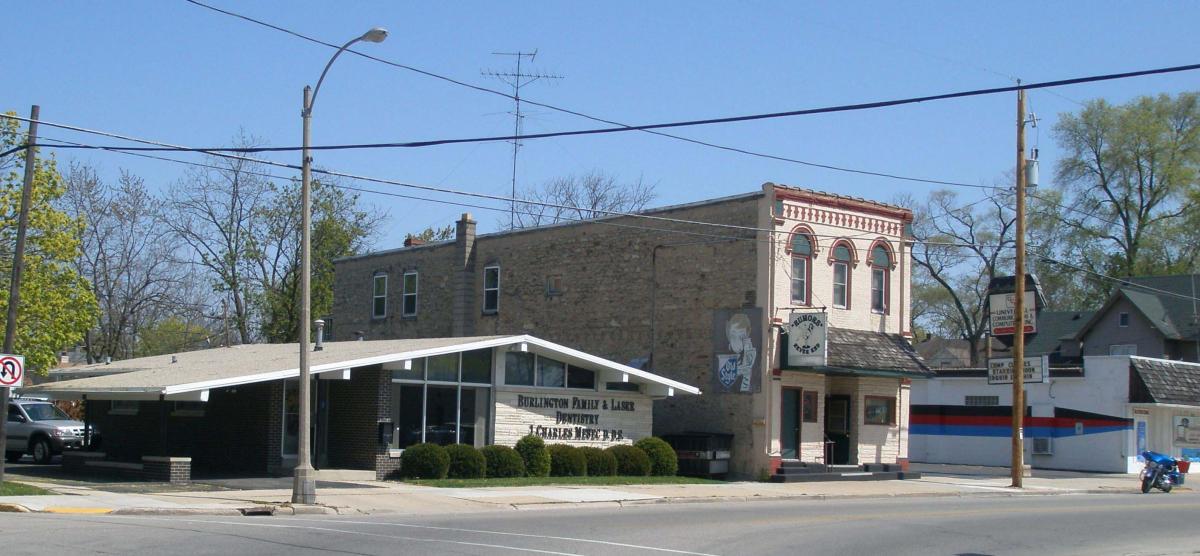
The "Then" portion of this month’s Then and Now feature consists of two photos, the top one on the right taken about 1882 and the top one on the left taken by Emmett Raettig in October 1956. The "Now" photo was taken in April 2010. All three photos show buildings on N. Main Street near the corner of Jefferson Street on the east side of the Fox River, which some have referred to, over the years, as "Canada."
The long, tall brick and stone building included in each photo is the building at what is now 232 N. Main Street. The building was erected by Christian Erdmann sometime before 1871 for use as both a store and residence. After Erdmann’s death in April 1880, Jacob Muth, Sr., rented the store portion from Mrs. Erdmann for his general merchandise and saloon business. Erdmann had earlier had a saloon in the building and a lumber yard nearby. The pump being operated in the center foreground of the circa 1882 photo topped a well that was dug in 1881 "by Messrs. Choak, Hussey, Madden & Co., at the Estate of Mrs. Ch. Erdmann, on the east side of the river, at the door of Mr. J. Muth's Grocery." The sign on the column supporting the corner of the upper porch nearest the camera advertises W. J. Finke’s Lager Beer, which was made at the Finke (later Finke and Uhen) brewery on McHenry Street.
The October 1956 Raettig photo shows the property north of the Erdmann building on the corner of Main and Jefferson Streets being used as a Chevrolet OK Used Car lot. About a year before that, Bryan Roberts had sold his Chevrolet dealership, called Union Chevrolet Co., to Herman Buelow and the dealership was renamed Humphrey Chevrolet Sales, Inc.
The April 2010 photo shows the dentistry building of Dr. J. Charles Mesec on the corner lot at 240 N. Main Street. The building was put up by dentist, Dr. Louis E. Ryall, in 1965. Dr. Ryall’s son, John, joined his father’s practice that same year and took over when his father retired in 1983. Dr. Mesec, who had worked with Dr. John Ryall, took over the dental practice in 1999.
The business in the Erdmann building, as shown in the April 2010 photo, is the Rumors Never End tavern. It is the latest in a series of businesses that have occupied the building over the years. The businesses included William Cunningham and Tony Kleinkopf’s Burlington Steam laundry, C. J. Jackson’s general store, Charles Zoske’s grocery and general store, Ben Willich’s grocery store, Henry Hoernemann’s grocery store and saloon, and the saloons or taverns of Albert J. Schultz, Joseph Schiller, Ben Hollencamp, Wenzel Tauscher, William and Mary Hoelz, Ben David, Harold Beix, Arthur Peterson, Fred Mischke, Harold Fugate, Jack Donahue, Pat Thomas, Patrick Schiller, E. J. O’Reilly, David Mitchell, and others. The businesses were known by such names as the Canadian Club, the Embassy Club, Grannie's East Side Pub, First Draft Saloon, and EJ’s Union Tap.
"Canada"
The earliest use in a Burlington newspaper of the term "Canada" to refer to the east side of the Fox River has been found in the March 1, 1865, Burlington Standard, in an advertisement by Martin Schaffer offering for sale "Town Lot no. 3, block 39, in the ‘Canada’ district of Burlington." That lot was located on East Street (now Capital Street) between Jefferson and Madison Streets. The term "Canada" had been used earlier to denote a section of Racine. An 1851 Racine newspaper referred to a portion of that village - the north side - which "is divided from us by the waters" not of the St. Lawrence but the more modest Root River, as "Canada."
WEST SIDE OF MILWAUKEE AVENUE BETWEEN ECHO LAKE AND GROVE STREET - 1896, 1957, AND 2010
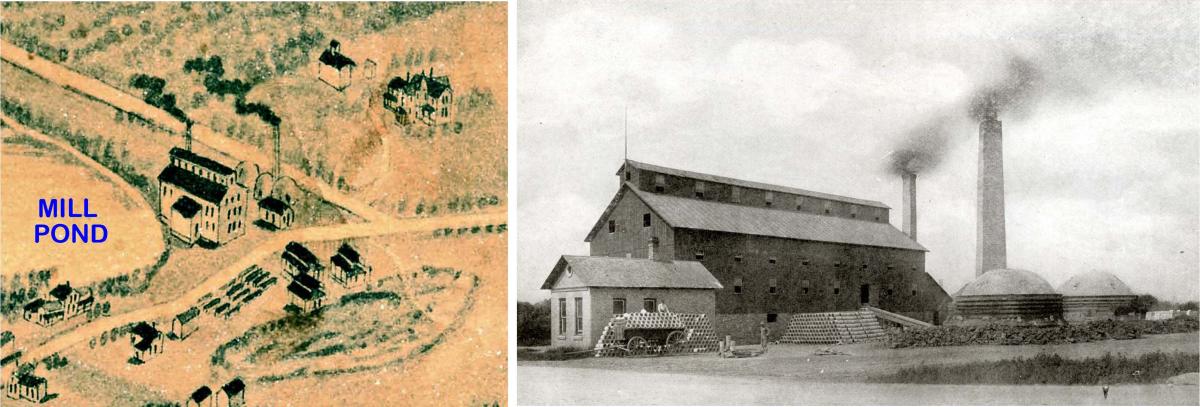


While the buildings on the west side of Milwaukee Avenue between Echo Lake and Grove Street, where Bruiser’s restaurant and Rice’s Liquor store are located, have changed in appearance over the last fifty-three years, the area itself doesn’t look much different than it did in 1957, when the Pure Oil service station and Shore-Line Gardens drive-in occupied the sites. Both scenes, however, are considerably different than the scene the people of the late 1800s and early 1900s saw when they went past the corner on their way to Rochester or Honey Creek.
At that time, the corner was occupied by the buildings and kilns of the Burlington Brick and Tile Co., which manufactured bricks for buildings, sidewalks, and streets and tile for draining farm fields and other lowlands. The company did a fairly good-sized business. In 1887, for example, plans called for the manufacture of 700,000 feet of tile and over 1 million bricks. The company’s sales area extended all the way to the Mississippi River and sometimes beyond. The clay for the bricks and tiles was dug from the area that Beaumont Field now occupies. That area is depicted in the lower center portion of the 1896 lithograph drawing by C. J. Pauli.
The photograph of the Brick and Tile Co. premises was taken by Howard A. Wood around 1908. There had been brickyards in that area as early as the 1860s (and possibly before that). The Brick and Tile Co. went out of business in the mid-1920s. It sold the clay field on the east side of the road in 1922 to the Burlington Club, a group of businessmen who transformed the area into a baseball field called Athletic Park (now Beaumont Field).
Albert Jung bought the property on the west side of the road containing the manufacturing facilities and office in 1931. He razed the buildings and kilns, except for the office building on the corner. Jung opened the Avalon filling station and a number of other businesses occupied the corner over the years. The former office building was torn down in 1956 and replaced by the service station building shown in the 1957 photo.
Jung built the Shore-Line Gardens drive-in across from the ballpark in 1952 after that property was rezoned from residential to commercial. Rice’s Liquor had its beginnings as an addition to Shore-Line Gardens, when the drive-in was run by Stanley Rice. The liquor store opened in 1961 and took over the entire building in 1968. Later operators of the business included Eugene and Annette Rice, Jim and Rose Rice, and Mike and Lorrie Dawson. Jim and Larry Jante, who opened Bruiser's restaurant in the former service station building in the mid-1990s, bought Rice’s Liquor store in 2006.
KANE STREET HOUSES BETWEEN DUANE STREET AND HIGHLAND AVENUE - EARLY 1900s - 2010
A few more trees in some spots, some variations in the porches, a few additions and additional buildings, and a different ground cover can't hide the features that have been preserved over more than 100 years in these four houses on the east side of Kane Street between the Duane Street intersection and Highland Avenue. Until 1893 this area along Kane Street was a part of the Frederick Stanton Perkins farm and had no houses. The top photo was taken in the early 1900s; the bottom photo, in February 2010.


The early 1900s photo, donated to the Burlington Historical Society by John Pieh, was taken with an Al-Vista panoramic camera. Pieh’s great grandfather, Leonard J. Smith, was mainly responsible for bringing Peter Angsten, the inventor of the Al-Vista camera, to Burlington and for establishing the Multiscope and Film Co., which manufactured the camera. The photo may even have been taken by Smith, who not only photographed many Burlington scenes but traveled to various places in the United States and in Europe taking photographs with the Al-Vista camera.
The house partially hidden behind the trees at the far left of the early 1900s photo was the William G. and Annibelle Rasch house. The house, whose current address is 224 S. Kane Street, was built by Charles W. Diener in 1895 and sold by his mother, Elise Grothkopf Diener, to W. G. Rasch in 1900. Mr. and Mrs. Rasch, who were prominent in Burlington’s business, community, and musical activities, lived in the house until their deaths, his in 1946 and hers in 1948. The house was willed to the City of Burlington with the stipulation that a room be reserved for meetings of the Woman’s Club and the Lyceum Club. Alternative arrangements were made and the City obtained clear title in 1950. It sold the house to A. W. Smith in 1951. Subsequent occupants included the Owen Lewis family, Mr. and Mrs. Joseph Suchy, the Harry Gregersen family, and the James Pihringer family.
The second house from the left, whose current address is 232 S. Kane Street, was built by Mrs. Fred Runkel, nee Lelia Stocker, in 1896. Mrs. Runkel, whose husband had died in 1887 at age 32, decided to go to medical school after his death, and graduated from the Women’s Medical College in Philadelphia in 1894. She never practiced the profession, but became interested in farming. Later occupants of the house have included the Andrew Adam, Jr., family and the Dr. Hugh Smith family.
The house directly facing the camera in both photos was built by Theodore Karges in 1904. Karges sold the house, whose current address is 248 S. Kane Street, to Henry R. Pruemers in 1907. Pruemers was postmaster of Burlington from 1924 to 1935 and served as mayor from April 1936 to April 1938. Paul Voss bought the Pruemers house in 1947. The Frank Voss family later lived in the house.
The house at the right, whose current address is 256 S. Kane Street, was built by Theodore Karges in 1893. The Karges family lived there until 1904, when Mr. Karges sold the house to Mrs. Gertrude Martin and moved to the adjoining house. Mrs. Martin’s daughter and son-in-law, Gertrude and Howard Wood, lived in the house for many years. Mr. Wood died in 1945; Mrs. Wood lived in the house until the 1960s. Subsequent occupants included the George Mann and James Stammers families.
CORNER OF LEWIS STREET AND MILWAUKEE AVENUE - 1907 - 2010


The large, stately John H. Uhen house, shown about 1907 in the left photo taken by Howard Wood, once stood on the corner of Milwaukee Avenue (formerly Geneva Street) and Lewis Street where Merten’s Service Center, shown in a 2010 Burlington Historical Society photo (at right), is now located. The Uhen house was built on the corner in 1896, replacing an earlier stone house which was moved south to the opposite side of the street where it still stands at 332 Milwaukee Avenue. That house, two doors up from the Burlington Fire Department building, is occupied by Dale Petersen Real Estate.
John H. Uhen, a partner with his brother-in-law, William J. Finke, in the Finke-Uhen Brewing Co., contracted with Fred Itzin, one of Burlington’s several fine house builders of that time, to construct the Uhen house. The brewery, which had been started by Uhen’s father-in-law (and William Finke’s father), Anton Finke, in 1856, was on McHenry Street across from what is now Aurora Memorial Hospital of Burlington. In 1920, the Finke-Uhen Brewing Co. donated the land on which the original hospital building was erected in 1924.
Uhen had the cement sidewalks, shown in the 1907 photo, laid in 1903, when the streets of Burlington were still dirt roads. Milwaukee Avenue, then called Geneva Street, was not paved until 1909. Lewis Street was not paved until a year or two later. The carriage block, located near the hitching post at the lower right on the Lewis Street side of the house, reads "John H. Uhen."
Uhen’s wife, Frances Finke Uhen, died in 1920, and Uhen died in 1926. Their daughter, Lauretta Uhen, continued to occupy the house until she entered St. Joseph’s convent in Milwaukee in 1939, becoming Sister Mary Miriam, O. S. F. The families of William B. Finke, Rudolph Uhen, R. C. Willoughby, Frank Warren, Andrew Rueter, Mrs. Dorothy Larson, Everard "Abe" Alby, Walter Kramer, Dr. Henry Blaisdell, and others also lived in the house for various periods.
The building shown to the right of both the Uhen house and the Merten Service Center was originally the coach house of the Uhen residence. In 2010 it was occupied by Pet-A-Groom pet grooming service at 117 Lewis Street. The building became a garage as the automobile replaced the horse and carriage. Later the building housed several businesses, including Alby Pontiac showroom, Chuck Thiel Auto Sales, Madden Import Sales (automobile dealer), the Coach House Gift Shop, Kingdom Hall, Gifts by Marcie, and State Farm Insurance.
The Uhen house was razed in 1957 to make way for Merten’s Pate Oil Co. service station, which opened in January 1958. The Merten station, which carried Marathon products in 2010, has also been a Total Oil Co. and Enco dealer for various periods. Over the years, the station has also offered auto repair, wrecker service, U-Haul, and emergency road service.
SOUTH CORNER OF CHESTNUT STREET AND MILWAUKEE AVENUE - EARLY 1920s - 2010
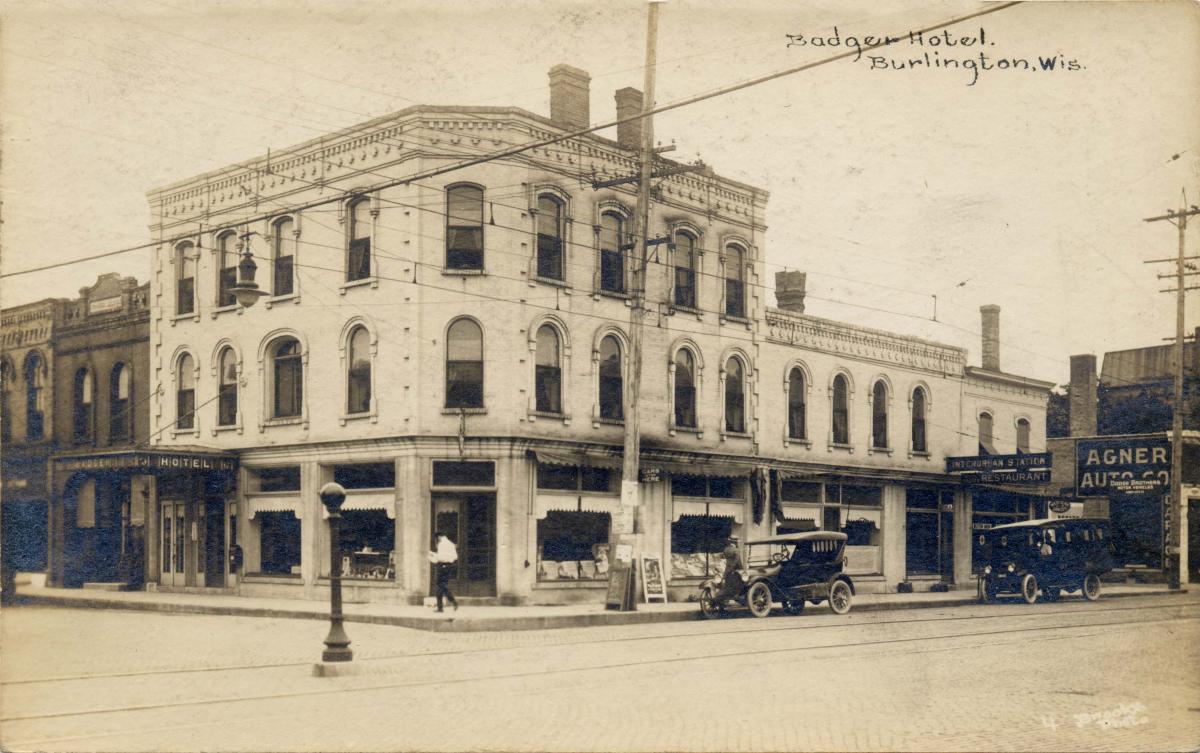

An October 1968 fire was the primary cause of the major difference seen in the two photos of the south corner of Chestnut Street and Milwaukee Avenue (previously Geneva Street). The photo with the three-story Badger Hotel building appeared on a postcard published by H. B. Brooks of Chicago, Illinois, in the early 1920s. The photo with the one-and-a-half story bar and grill building was taken in 2010 by John Zwiebel, veteran Burlington photographer and member of the Burlington Historical Society.
The early 1920s photo shows the Badger Hotel at a time when it was a major establishment in downtown Burlington. The three-story brick hotel building, which had earlier been known as the Jones House, was erected by Charles J. Jones in 1873, replacing a two-story brick hotel building that Jones had built in 1868. (That building had, in turn, replaced an earlier wooden hotel and store building that had been built by Pliny Perkins and Hugh McLaughlin in 1839.) Jones moved the two-story building, which is seen to the right of the corner building, to make room for the larger building. The slightly smaller two-story building farther to the right housed the Jones House livery office and, later, stores on the ground floor.
Fred Oberg bought the Jones House from Charles A. Jones (son of Charles J.) in 1915. Selling an interest to his brother-in-law, Charles Cote, the two named the place, the Fritz-Karl Hotel. In 1918, they changed the name to the Hotel Badger because of the war with Germany. In 1923 the former livery office building was razed and the three-story building shown in the recent photo was erected by Oberg. The addition added 16 rooms to the hotel operation. The first floor of the building housed a variety of businesses over the years, including the Western Union telegraph office, the Burlington Floral Co., Partee's Beauty Shop, Bob Steele's liquor store, a radio shop, a Maytag washer agency, Ford Cleaners, Craft's barber shop, Floyd Strohm's barber shop, and Mangold Insurance.
Oberg sold the hotel business in 1946, but retained ownership of the building. In 1961 Elmer Droster and Carl Backlin bought the hotel building from Mrs. Elsie Oberg who, along with others, had operated the hotel after her husband's death in 1947. Within a short time, Droster purchased Backlin’s interest and, in 1966, sold the building to William A. Johnson. On October 27, 1968, a fire that started in the Coach Lamp restaurant portion of the building caused $100,000 damage. Following the fire, the upper floors were demolished while the exterior walls of the ground floor were salvaged.
Since the renovation of the ground floor, the building has housed a series of businesses, including the Coach Lamp restaurant, the Covered Wagon restaurant and cocktail lounge, the Burlington Corner House restaurant and lounge, The Eagle's Nest, and, since the early 1990s, Coach's Sports Bar & Grill.
